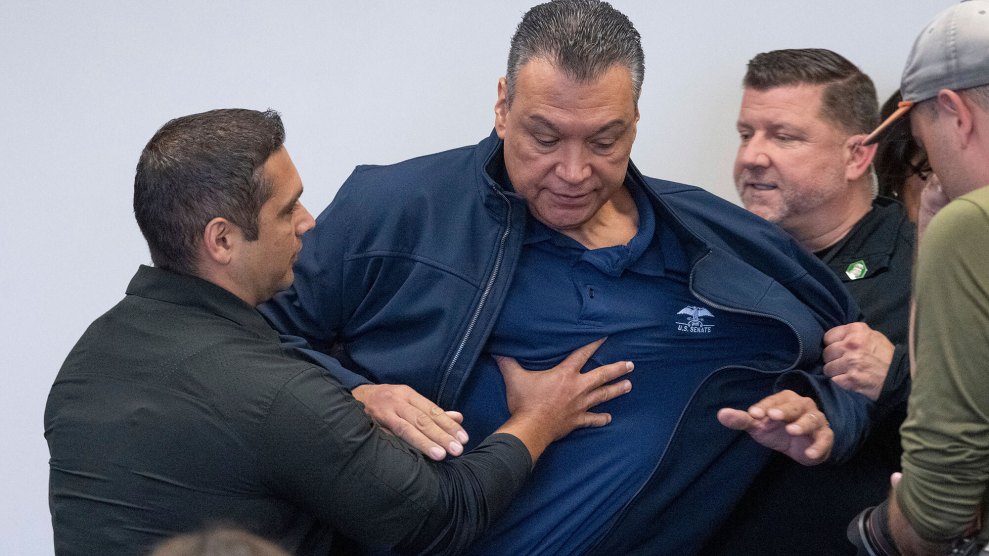M A R R Y I N G G R A S S R O O T S & I N F L U E N C E - P E D D L I N G
Ramhurst grew out of an earlier operation, set up by RJR executive Mike Phillips in the mid-1980s. Phillips’ team hosted dozens of smokers’ rights group meetings around the country; those groups grew rapidly and were coordinated by an RJR team of field operatives and consultants, some of whom had strong backgrounds in conservative and GOP politics.
Two of these operatives, James Ellis, 39, and Doug Goodyear, 36, came up with the idea of launching Ramhurst in late 1993. Ellis, who had worked for Paul Weyrich’s ultraconservative Free Congress Foundation before going to RJR in the late ’80s, became Ramhurst’s president; Goodyear, a former GOP political operative in Colorado and New Jersey, became the company’s vice president and treasurer. Ramhurst is secretive about some pertinent details–such as how much money it receives from RJR yearly, and the size of the RJR mailing lists it taps to develop its campaigns.
From its inception, Ramhurst worked to refine the grassroots lobbying techniques used by RJR and the tobacco company’s longtime consultant, Walt Klein & Associates. But to help RJR get more bang for its buck, Ramhurst married that strategy to some aggressive influence-peddling within the GOP.
T H E D E L A Y C O N N E C T I O N
Ramhurst, which has a full-time staff of just three, boasts a sophisticated nationwide network of about two dozen independent contractors who help mobilize coalitions of smokers, conservative activists, and business allies to block regulations and expensive new taxes on tobacco products. These operatives, some of whom have their own firms, spend about half their time handling Ramhurst work for RJR and several other business and political clients; the rest of the time, they’re free to conduct their own grassroots work. In fact, several of Ramhurst’s grassroots gurus also are playing growing roles in the political fortunes and campaigns of leading GOP members.
The biggest coup for Ramhurst so far has been its relationship with Majority Whip Tom DeLay (R-Texas). Last summer, DeLay’s leadership PAC, Americans for a Republican Majority (ARMPAC), contracted with Ramhurst to hire its operative Karl Gallant, a former lobbyist for the anti-union National Right to Work Committee and an old friend of DeLay’s. ARMPAC named Gallant, who continues to work for Ramhurst, as its executive director. His hiring represents a kind of package deal: When DeLay does fundraising appearances around the country, Gallant can call on other Ramhurst operatives to help out.
Nor is this Gallant’s first connection to top congressional Republicans. In the second half of 1994, Gallant had an outside consulting contract with Bob Dole’s leadership PAC, Campaign America, advising the PAC on which GOP candidates to support in Pennsylvania and Ohio.
The Ramhurst-DeLay connection has already yielded dividends for both. In December, DeLay figured prominently among the 156 members of Congress who signed letters opposing FDA regulation of tobacco. Meanwhile, the tobacco money flowing into ARMPAC has helped DeLay become the most successful–and influential–fundraiser in the GOP Congress after Newt Gingrich. By doling out hundreds of thousands of dollars from ARMPAC to Republican candidates in need, DeLay has dramatically increased his clout with fellow Republicans.
Part of ARMPAC’s power comes from its unique structure as both a federal and a state PAC. That flexibility has allowed RJR to direct huge corporate contributions in at least one state–Virginia–in an effort to gain political ground for tobacco interests in the state legislature. Last year, ARMPAC raised at least $175,000 from corporations in Virginia to support GOP candidates. A whopping $73,000 came from RJR, and Philip Morris also kicked in $10,000.
Virginia–in the heart of tobacco country–was not picked as a battleground by accident. Two PACs run by GOP leaders and some big business PACs invested heavily in the state’s Republican challengers because the legislature, long under Democratic control, seemed as though it might be up for grabs and could become even more tobacco-friendly. ARMPAC gave $27,500 to 15 GOP candidates for the Virginia legislature and reported that it spent about $48,000 on fundraising expenses. (Only two of the 15 candidates backed by ARMPAC won seats, and the effort to take control of the legislature failed.)
This year, ARMPAC has already made contributions to GOP challengers in a few states, including California, Kentucky, and Tennessee, where the Republicans hope to gain more seats. To keep its coffers well stocked, DeLay held a big bash in Houston in January to honor Gingrich; the event pulled in about $280,000. Gallant and ARMPAC also plan to be active at the August GOP convention in San Diego.
Where else will ARMPAC be at work? Gallant declined to discuss his activities for Ramhurst with Mother Jones. Last year, he told the National Journal that ARMPAC will comply with all regulations about reporting donations in states that require it. But he made it clear that he is hardly going to provide information where the law doesn’t mandate it. “Why give the enemy your blueprint for action?Ó he asked. “We’re not going to unilaterally disarm.”
O T H E R F R I E N D S I N C O N G R E S S
Like Gallant, other Ramhurst operatives have capitalized on the company’s loose structure to develop ties to the top echelon of the GOP Congress:
- Dole, besides having employed Gallant as a consultant, has long turned to grassroots specialist Tom Synhorst for campaign advice. Synhorst, who runs the Kansas City-based telemarketing company Direct Connect, is also one of Ramhurst’s most important operatives. Direct Connect works for Ramhurst in several states, including Missouri, Iowa, Kansas, and Nebraska.
- Ramhurst’s Gallant was retained to consult and raise funds for the campaign coffers of freshman Rep. John Shadegg (R-Ariz.). Shadegg’s star rose last year when he became chairman of GOPAC, the powerful PAC formerly run by Speaker Newt Gingrich. (According to Common Cause, RJR has also aided GOPAC, with contributions of at least $50,000 in recent years.)
- For extra political cachet, Ramhurst last year signed on David Armey, the 20-something son of House Majority Leader Dick Armey (R-Texas), as an operative. “We’re looking for new blood all the time,” says Mike Phillips, RJR’s director of field operations who oversees Ramhurst. “He’s a sharp kid.”
Thus far, Armey (who didn’t return Mother Jones‘ phone calls) has worked on local issues in a few states, including Texas, Florida, and Montana, according to Phillips. One of his first battles was in Texas last spring, where he helped drum up support for an unsuccessful effort to overturn a local smoking ban in Wichita Falls (see “Texas”).
" G R A S S R O O T S " C A M P A I G N S
In addition to creating close ties with GOP politicians, Ramhurst also has been artful at linking tobacco interests to other, more broad-based efforts. According to RJR’s Phillips, as much as 75 percent of Ramhurst’s work is at the state level. During 1994, for example, Ramhurst and RJR took part in the successful all-out assault by GOP, business, and conservative groups nationwide to kill the Clinton proposal that would have raised excise taxes 75 cents per pack to pay for health care reform.
“We held meetings with smokers and retailers,” recalls Goodyear, Ramhurst’s vice president. “We did town hall meetings with congressmen. We encouraged letters to members. I think that was one of our biggest accomplishments. Tobacco looked like it was going to take a big hit.”
Ramhurst also maximized RJR’s political leverage by working with powerful trade associations like the National Federation of Independent Business Inc., Washington’s top small-business lobbying group. In the 1994 elections, NFIB retained Ramhurst to organize in about 14 congressional districts where NFIB hoped to elect GOP candidates.
Increasingly, Ramhurst is working with anti-tax groups, including Americans for Tax Reform, the National Taxpayers Union, and Citizens for a Sound Economy, says Goodyear. Last year, for example, Ramhurst helped derail a proposed New Jersey excise tax hike backed by Republican Gov. Christine Todd Whitman. Key to Ramhurst’s success was forming alliances with groups opposed to taxes in general. “We try to reach out to like-minded people,” says Goodyear. “Anti-tax groups are natural ones for us to reach out to.”
Some of these groups, besides being ideological foes of tax hikes, have also been funded by the tobacco industry. Citizens for a Sound Economy (CSE), which led the New Jersey lobbying drive, received between $100,000 and $200,000 from Philip Morris in the early ’90s. RJR also gave CSE an unknown amount of direct funds and provided the group with the use of its field operatives to fight the Clinton health plan. Similarly, the National Taxpayers Union, which has an annual budget of about $5 million, has received “significant” contributions from Philip Morris, according to director David Keating.
T H E M O V E T O T H E S T A T E S
Though it has grown quickly, the Ramhurst operation still remains just one facet of Big Tobacco’s multimillion- dollar-a-year jihad against government efforts to control tobacco. For Ramhurst and the tobacco industry, the stakes keep getting higher and the fights more intense. “The nature of the battle keeps changing,” says Goodyear.
One of the most significant challenges the industry faces is the recent proliferation of local efforts to control tobacco. Victor Crawford, a former lobbyist for tobacco interests who became an anti-smoking advocate, summed up the problem in an interview early this year. “We started getting killed when the consumers started moving from the national level to the state and local levels,” recalled Crawford, a longtime chain-smoker who died of lung and throat cancer in March. “We started getting a shellacking.”
Peter H. Stone covers lobbying and campaign finance issues for the National Journal.
















